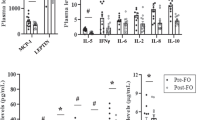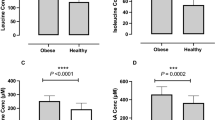Abstract
Objective:
In the metabolic syndrome (MetS), increased fat storage in ‘nonadipose’ tissues such as skeletal muscle may be related to insulin resistance (‘lipid overflow’ hypothesis). The objective of this study was to examine the effects of dietary fat modification on the capacity of skeletal muscle to handle dietary and endogenous fatty acids (FAs).
Subjects and Methods:
In total, 29 men with the MetS were randomly assigned to one of four diets for 12 weeks: a high-fat saturated fat diet (HSFA, n=6), a high-fat monounsaturated fat diet (HMUFA, n=7) and two low-fat high-complex carbohydrate diets supplemented with (LFHCCn−3, n=8) or without (LFHCC, n=8) 1.24 g per day docosahexaenoic and eicosapentaenoic acid. Fasting and postprandial skeletal muscle FA handling was examined by measuring arteriovenous concentration differences across the forearm muscle. [2H2]-palmitate was infused intravenously to label endogenous triacylglycerol (TAG) and free fatty acids in the circulation and subjects received a high-fat mixed meal (2.6 MJ, 61 energy% fat) containing [U-13C]-palmitate to label chylomicron-TAG.
Results:
Postprandial circulating TAG concentrations were significantly lower after dietary intervention in the LFHCCn−3 group compared to the HSFA group (ΔiAUC −139±67 vs 167±70 μmol l−1 min−1, P=0.009), together with decreased concentrations of [U-13C]-labeled TAG, representing dietary FA. Fasting TAG clearance across forearm muscle was decreased on the HSFA diet, whereas no differences were observed in postprandial forearm muscle FA handling between diets.
Conclusion:
Chronic manipulation of dietary fat quantity and quality did not affect forearm muscle FA handling in men with the MetS. Postprandial TAG concentrations decreased on the LFHCCn−3 diet, which could be (partly) explained by lower concentration of dietary FA in the circulation.
This is a preview of subscription content, access via your institution
Access options
Subscribe to this journal
Receive 12 print issues and online access
$259.00 per year
only $21.58 per issue
Buy this article
- Purchase on Springer Link
- Instant access to full article PDF
Prices may be subject to local taxes which are calculated during checkout





Similar content being viewed by others
References
Eckel RH, Grundy SM, Zimmet PZ . The metabolic syndrome. Lancet 2005; 365: 1415–1428.
Blaak EE . Basic disturbances in skeletal muscle fatty acid metabolism in obesity and type 2 diabetes mellitus. Proc Nutr Soc 2004; 63: 323–330.
Frayn KN . Adipose tissue as a buffer for daily lipid flux. Diabetologia 2002; 45: 1201–1210.
Blaak EE, Wagenmakers AJ, Glatz JF, Wolffenbuttel BH, Kemerink GJ, Langenberg CJ et al. Plasma FFA utilization and fatty acid-binding protein content are diminished in type 2 diabetic muscle. Am J Physiol Endocrinol Metab 2000; 279: E146–E154.
Mensink M, Blaak EE, van Baak MA, Wagenmakers AJ, Saris WH . Plasma free fatty acid uptake and oxidation are already diminished in subjects at high risk for developing type 2 diabetes. Diabetes 2001; 50: 2548–2554.
Corcoran MP, Lamon-Fava S, Fielding RA . Skeletal muscle lipid deposition and insulin resistance: effect of dietary fatty acids and exercise. Am J Clin Nutr 2007; 85: 662–677.
Schmitz-Peiffer C . Signalling aspects of insulin resistance in skeletal muscle: mechanisms induced by lipid oversupply. Cell Signal 2000; 12: 583–594.
Schrauwen P, Hesselink MK . Oxidative capacity, lipotoxicity, and mitochondrial damage in type 2 diabetes. Diabetes 2004; 53: 1412–1417.
Madsen L, Petersen RK, Kristiansen K . Regulation of adipocyte differentiation and function by polyunsaturated fatty acids. Biochim Biophys Acta 2005; 1740: 266–286.
Gaster M, Rustan AC, Beck-Nielsen H . Differential utilization of saturated palmitate and unsaturated oleate: evidence from cultured myotubes. Diabetes 2005; 54: 648–656.
Lee JS, Pinnamaneni SK, Eo SJ, Cho IH, Pyo JH, Kim CK et al. Saturated, but not n-6 polyunsaturated, fatty acids induce insulin resistance: role of intramuscular accumulation of lipid metabolites. J Appl Physiol 2006; 100: 1467–1474.
Roberts R, Bickerton AS, Fielding BA, Blaak EE, Wagenmakers AJ, Chong MF et al. Reduced oxidation of dietary fat after a short term high-carbohydrate diet. Am J Clin Nutr 2008; 87: 824–831.
Bickerton AS, Roberts R, Fielding BA, Hodson L, Blaak EE, Wagenmakers AJ et al. Preferential uptake of dietary fatty acids in adipose tissue and muscle in the postprandial period. Diabetes 2007; 56: 168–176.
Shaw DI, Tierney AC, McCarthy S, Upritchard J, Vermunt S, Gulseth HL et al. LIPGENE food-exchange model for alteration of dietary fat quantity and quality in free-living participants from eight European countries. Br J Nutr 2009; 101: 750–759.
Third Report of the National Cholesterol Education Program (NCEP) Expert Panel on Detection, Evaluation, and Treatment of High Blood Cholesterol in Adults (Adult Treatment Panel III) final report. Circulation 2002; 106: 3143–3421.
Finegood DT, Hramiak IM, Dupre J . A modified protocol for estimation of insulin sensitivity with the minimal model of glucose kinetics in patients with insulin-dependent diabetes. J Clin Endocrinol Metab 1990; 70: 1538–1549.
Boston RC, Stefanovski D, Moate PJ, Sumner AE, Watanabe RM, Bergman RN . MINMOD Millennium: a computer program to calculate glucose effectiveness and insulin sensitivity from the frequently sampled intravenous glucose tolerance test. Diabetes Technol Ther 2003; 5: 1003–1015.
Matthews DR, Hosker JP, Rudenski AS, Naylor BA, Treacher DF, Turner RC . Homeostasis model assessment: insulin resistance and beta-cell function from fasting plasma glucose and insulin concentrations in man. Diabetologia 1985; 28: 412–419.
Wolfe RR . Radioactive and Stable Isotope Tracers in Biomedicine: Principles and Practice of Kinetic Analysis. Wiley-Liss: New York, NY, 1992.
Corpeleijn E, Mensink M, Kooi ME, Roekaerts PM, Saris WH, Blaak EE . Impaired skeletal muscle substrate oxidation in glucose-intolerant men improves after weight loss. Obesity (Silver Spring) 2008; 16: 1025–1032.
Corpeleijn E, Saris WH, Blaak EE . Metabolic flexibility in the development of insulin resistance and type 2 diabetes: effects of lifestyle. Obes Rev 2009; 10: 178–193.
Buettner R, Scholmerich J, Bollheimer LC . High-fat diets: modeling the metabolic disorders of human obesity in rodents. Obesity (Silver Spring) 2007; 15: 798–808.
Storlien LH, Jenkins AB, Chisholm DJ, Pascoe WS, Khouri S, Kraegen EW . Influence of dietary fat composition on development of insulin resistance in rats. Relationship to muscle triglyceride and omega-3 fatty acids in muscle phospholipid. Diabetes 1991; 40: 280–289.
Storlien LH, Kraegen EW, Chisholm DJ, Ford GL, Bruce DG, Pascoe WS . Fish oil prevents insulin resistance induced by high-fat feeding in rats. Science 1987; 237: 885–888.
Hegarty BD, Cooney GJ, Kraegen EW, Furler SM . Increased efficiency of fatty acid uptake contributes to lipid accumulation in skeletal muscle of high fat-fed insulin-resistant rats. Diabetes 2002; 51: 1477–1484.
Schrauwen-Hinderling VB, Kooi ME, Hesselink MK, Moonen-Kornips E, Schaart G, Mustard KJ et al. Intramyocellular lipid content and molecular adaptations in response to a 1-week high-fat diet. Obes Res 2005; 13: 2088–2094.
Krssak M, Falk Petersen K, Dresner A, DiPietro L, Vogel SM, Rothman DL et al. Intramyocellular lipid concentrations are correlated with insulin sensitivity in humans: a 1H NMR spectroscopy study. Diabetologia 1999; 42: 113–116.
Tierney AC, Gulseth HL, Defoort C, Lovegrove JA, Blaak E, Lopez-Miranda J et al. The effects of dietary fat modification on metabolic markers of the metabolic syndrome—insights from the LIPGENE Dietary Intervention Study. Diabetologia 2008; 51: S108.
Park Y, Harris WS . Omega-3 fatty acid supplementation accelerates chylomicron triglyceride clearance. J Lipid Res 2003; 44: 455–463.
Harris WS, Bulchandani D . Why do omega-3 fatty acids lower serum triglycerides? Curr Opin Lipidol 2006; 17: 387–393.
Rivellese AA, Maffettone A, Vessby B, Uusitupa M, Hermansen K, Berglund L et al. Effects of dietary saturated, monounsaturated and n-3 fatty acids on fasting lipoproteins, LDL size and post-prandial lipid metabolism in healthy subjects. Atherosclerosis 2003; 167: 149–158.
Harris WS, Lu G, Rambjor GS, Walen AI, Ontko JA, Cheng Q et al. Influence of n-3 fatty acid supplementation on the endogenous activities of plasma lipases. Am J Clin Nutr 1997; 66: 254–260.
Colberg SR, Simoneau JA, Thaete FL, Kelley DE . Skeletal muscle utilization of free fatty acids in women with visceral obesity. J Clin Invest 1995; 95: 1846–1853.
Kelley DE, Simoneau JA . Impaired free fatty acid utilization by skeletal muscle in non-insulin-dependent diabetes mellitus. J Clin Invest 1994; 94: 2349–2356.
Acknowledgements
We thank all volunteers for their time and motivation, and all researchers within the LIPGENE Human Dietary Intervention Study for their work and dedication to the project. We also thank J Stegen, W Sluijsmans, H Aydeniz, R Jacobs and A Gijsen for their excellent analytical support, and M Ockeloen-Van der Hulst, T Hermans-Limpens, D Mintjens, P Goyens, N Jansink and A van de Loo for their excellent practical support and dietary advice. This work was part of the LIPGENE project, an EU Sixth Framework Integrated Program funded by the European Community (Contract No. FOOD-CT-2003-505944). Full project title: ‘Diet, genomics and the metabolic syndrome: an integrated nutrition, agro-food, social and economic analysis.’ Trial Number: NCT00429195 (ClincialTrials.gov).
Author information
Authors and Affiliations
Consortia
Corresponding author
Ethics declarations
Competing interests
The authors declare no conflict of interest.
Rights and permissions
About this article
Cite this article
van Hees, A., Saris, W., Hul, G. et al. Effects of dietary fat modification on skeletal muscle fatty acid handling in the metabolic syndrome. Int J Obes 34, 859–870 (2010). https://doi.org/10.1038/ijo.2010.6
Received:
Revised:
Accepted:
Published:
Issue Date:
DOI: https://doi.org/10.1038/ijo.2010.6



